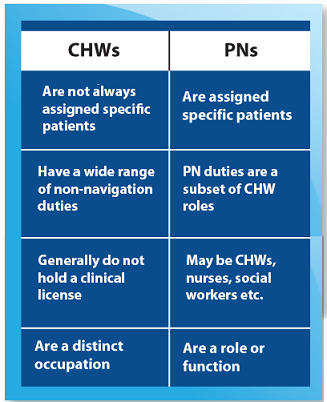CHWs vs. Patient Navigators
| < Back | Next > |
|---|
 The differences between CHWs and Patient Navigators include:
The differences between CHWs and Patient Navigators include:
- PNs are assigned to specific patients; CHWs often are not
- PN duties are a subset of CHW duties
- PNs may have other occupational background
- PN is a role or function; CHW is a distinct occupation
View Transcript
[SPEAKER]
Let’s pause for a moment to review one of the persistent definitional issues for this field. The term “patient navigator” is attributed to Dr. Harold Freeman, who created the navigator model at Harlem Hospital in New York in the early 1990s. The patient navigator accompanies and coaches a patient from the point of a positive screening test for cancer through diagnosis and treatment, helping the patient navigate the complexities of cancer treatment. The approach is also useful for patients with other complex medical needs. The concept of the patient navigator has steadily gained popularity, particularly in the field of cancer treatment.
We will see in a moment how the duties of the patient navigator overlap the range of duties of the CHW, but many stakeholders have treated the distinction between CHWs and patient navigators very casually. Some believe they are the same; some believe they are “just different.” These interpretations are clearly not sufficient in a serious policy discussion.
The first important distinction between CHWs and navigators is that navigators are typically assigned to specific patients and follow them for an extended period during diagnosis and treatment. Although CHWs may work with patients in a similar manner, they also may have a variety of short-term interactions with patients and with community members who are not currently patients of the provider organization. They may, for example, encourage community members to participate in cancer screening, whereas the navigator’s role begins when a patient receives a positive screening test.
Looking back to the range of roles and functions just discussed, it is clear that the duties of the patient navigator are a subset of CHWs’ potential roles and functions. For example, patient navigators seldom have outreach or community organizing responsibilities.
That said, many patient navigator programs employ CHWs. Although the 2005 Patient Navigator Act did not mention CHWs or the characteristics of CHWs as navigators, HRSA has embraced CHWs as navigators in implementing this Act. In its funding announcements in 2008 and 2010, HRSA required applicants wishing to use non-CHWs as navigators to justify their choice.
At the same time, it is not uncommon for nurses, social workers, or others, such as health educators or dental hygienists, to assume the role of patient navigator. These are perfectly valid program design choices.
It follows, then, that patient navigation is a role or function and not a distinct occupation. In other words, not all CHWs are navigators, and vice versa.
- Page last reviewed: January 26, 2016
- Page last updated: January 26, 2016
- Content source:



 ShareCompartir
ShareCompartir